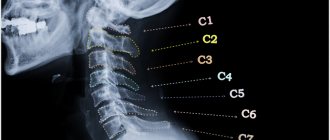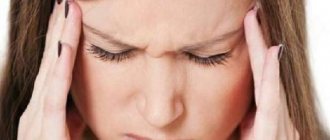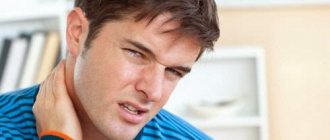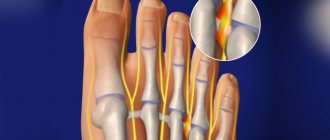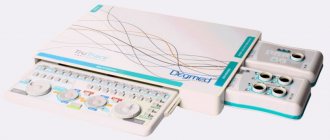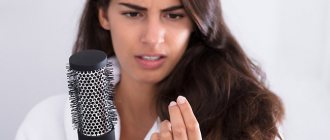If you are bothered by throbbing pain on the left side of your head, then study the information in the article. This will help you find out the reason.
None of us are immune to encountering a throbbing headache that is localized on the left side of the head. Unfortunately, many people do not come to a consultation with a specialist, continuing to go about their daily activities despite the annoying discomfort. They do not think that such a symptom can lead to a malfunction of the entire body or be the cause of a dangerous disease.
If you do not take into account the accompanying symptoms, after some time the painful sensations may reappear and lead to the development of pathology. All this entails serious consequences, including the development of complex pathologies and even death. Read in this article
Causes of throbbing pain in the back of the head
The feeling that the back of the head is throbbing from a headache indicates damage to the nerves or blood vessels, their inflammation or mechanical compression. Based on the intensity and nature of the painful sensations, we can tentatively assume their cause:
- acute, throbbing pain in the back of the head, which spreads to the entire surface of the head - infectious diseases, including influenza, meningitis, encephalitis;
- sharp pain in the form of repeated attacks is a manifestation of cervical migraine;
- unilateral or symmetrical pain in the back of the head, which causes numbness in the hands - damage to the occipital nerve;
- dull, aching pain – ischemia, insufficient blood supply to the occipital region.
If throbbing pain in the back of the head is accompanied by numbness in the hands, impaired hearing, vision or speech, or coordination of movements, it is important to exclude the possibility of a stroke. You should consult a doctor within the first 2 hours after an attack - it is during this period that medical care is most effective.
Vascular diseases
Pulsation in the back of the head is one of the manifestations of acute and chronic diseases of the vascular system. Important arteries that carry blood to the brain may be compressed from the outside or blocked from the inside. These processes, as well as infectious diseases, are accompanied by inflammation, pain, and insufficient blood supply to certain areas. These include:
- atherosclerosis is a chronic metabolic pathology in which the products of fat metabolism are deposited on the inner wall of the arteries and cholesterol plaques are formed;
- vasculitis - inflammation of blood vessels caused by injuries, compression of arteries or veins, as well as infectious processes;
- Vascular dystonia is a complex disorder that is accompanied by frequent surges in pressure and insufficient blood supply to the head and lower extremities.
For various vascular diseases, it is important to restore normal blood flow in the head, neck and back of the head. For this, medications, exercises, and physiotherapy sessions are prescribed. If acute or chronic vascular diseases are suspected, an ultrasound examination with a contrast agent is performed.
Diseases of the cervical spine
Throbbing pain in the back of the head can be a sign of acute or chronic neck diseases. They cause compression or spasm of the vertebral artery, which is important for cerebral circulation. As a result, the patient experiences acute, throbbing pain in the back of the head, dizziness, nausea, hearing and vision impairment. Symptoms disappear after a course of treatment, which eliminates the underlying cause of the pain.
As a result of diagnostics, the following violations may be detected:
- osteochondrosis is a chronic disease of the joints of the spine, which leads to thinning of the cartilage discs and deformation of the vertebrae;
- displacements and subluxations of the vertebrae - a violation of the anatomically correct placement of segments of the spinal column, which causes compression of the vessels and roots of the spinal nerves;
- protrusion of intervertebral discs - protrusion of cartilage in any direction, which is accompanied by acute pain in the neck and back of the head, as well as limited mobility;
- spondylosis is the fusion of two or more adjacent vertebrae as a result of trauma, surgery, or chronic deforming processes.
Cervical migraine is a disease that often progresses. It can worsen when weather or climate conditions change, or due to stress or physical exertion. The condition can be normalized with painkillers and antispasmodics, and the doctor can also prescribe muscle relaxants.
High blood pressure
Hypertension is considered a disease of older people, but in reality it can occur at any age. Increased stress, weakness of the vascular walls, excess weight and poor diet, as well as cardiac dysfunction are the main causes of this disease. Hypertension is considered to be an increase in blood pressure to levels greater than 120∕80 mm. rt. Art.
High blood pressure can be identified by the following symptoms:
- throbbing pain in the head, in the occipital region;
- dizziness, with a sharp increase in pressure, fainting is possible;
- redness of the facial skin, burning sensation, tingling, numbness;
- deterioration of hearing and vision, the appearance of dark circles before the eyes.
Doctors at the Clinical Institute of the Brain recommend having a tonometer in your home medicine cabinet, even if you have not previously experienced problems with high or low blood pressure. It is important to know your own normal indicators in order to notice the onset of an attack in time. They should be measured at rest - after physical activity and stress, pressure normally increases.
Neuralgia
Throbbing pain in the back of the head is one of the first signs of occipital neuralgia. It originates from the second cervical vertebra, passes through the muscles of the neck, under the base of the skull and goes to the scalp. Neuralgia refers to painful sensations that occur due to inflammation or mechanical compression of a nerve. The pain is acute, throbbing, lasts from several hours to several days, disappears after taking analgesics. Its causes may be:
- cervical spine injuries are the most common cause;
- degenerative diseases of the first two cervical vertebrae;
- arthritis – inflammatory diseases of the joints;
- neoplasms that compress the nerve.
Occipital neuralgia can occur in the absence of any congenital anomalies or chronic diseases. Its development is facilitated by incorrect posture, prolonged sitting, stress and other factors. One common cause is a spasm of the neck muscles, in which the nerve is compressed as it passes through this area.
Other reasons
If pain in the back of the head throbs frequently, this should be a reason for a full examination. During diagnosis, various disorders may be detected that require timely treatment:
- neoplasms located in the back of the head;
- diseases of the muscles of the back of the neck;
- increased intracranial pressure;
- migraine.
Headache is not the only symptom that indicates diseases of the heart and blood vessels, nervous system, neck and spine. It may be accompanied by nausea, deterioration of memory and attention, numbness of the hands and fingers, and sleep disorders.
What pathologies cause tinnitus?
The feeling that the heartbeat is pounding in the ears and head is caused by increased pulsation of the blood vessels of the brain and indicates the following serious diseases:
- stenosis or thrombosis of blood vessels;
- increased pressure in the blood vessels of the brain;
- vascular angioma - a tumor of blood or lymphatic vessels;
- atriovenous fistula - a pathological connection between a vein and an artery;
- Aneurysm is a bulging or widening of artery walls.
In addition to vascular pathology, the causes of pulse in the ears are benign or malignant tumor processes: paraganglioma of the ear, acoustic neuroma.
There are a lot of diseases that cause the feeling of subjective tinnitus. The most common of them:
- foreign body or wax plug in the ear;
- external and otitis media;
- post-traumatic complications;
- Meniere's disease;
- decompression sickness.
Also, noise and palpitations in the ears are a symptom of hypertension. Prolonged course of the disease without adequate treatment leads to disruption of receptor-conducting activity and hearing loss. Atherosclerosis of the neck vessels further aggravates the situation. The blood, encountering lipid plaques, undergoes turbulence, and a sound effect occurs. The condition is worsened by headache and general weakness.
Tinnitus can be a sign of mental disorders (schizophrenia). Patients experience auditory hallucinations in the form of various voices, the sound of music and clicks.
Among the disorders of the nervous system, the most common is vegetative-vascular dystonia, in which the pounding in the ears is not constant and is combined with tachycardia and increased sweating. Sometimes tinnitus accompanies migraine attacks, then it is preceded by an aura (sensation of foreign odors, dry mouth). At the end of the exacerbation, the noise goes away on its own.
Diagnostic methods
To prescribe an effective treatment regimen, it is important to understand the cause of throbbing pain in the back of the head. Doctors at the Clinical Institute of the Brain recommend signing up for an examination if the attacks are repeated frequently and are of high intensity. To confirm the diagnosis, consultations with a therapist, neurologist, traumatologist, surgeon, as well as additional examinations may be required:
- MRI of the head and neck to exclude any damage, neoplasms, or diseases of the spine;
- magnetic resonance angiography is a method of examining the vessels of the head and neck in order to identify their inflammation, blockage, and also detect areas of ischemia;
- Dopplerography – ultrasound diagnostics of blood vessels using a contrast agent;
- ophthalmological examinations - checking the fundus, determining visual acuity, measuring intraocular pressure;
- blood tests to identify inflammatory processes and dysfunction of individual organs.
The Clinical Institute of the Brain has all the conditions for a full diagnosis of headaches in the back of the head. Our advantages are high-quality, modern equipment and specialists who regularly improve their skills.
Making a diagnosis in a medical institution
Once this problem occurs, you should immediately go to the hospital. The specialist is recommended to tell you where the pulsation is localized, at what time it appears, how often it occurs, what provokes the condition, and whether there is pain.
In most cases, timely consultation with a doctor helps to avoid unwanted consequences.
The following is prescribed as a diagnosis:
- blood and urine tests;
- Magnetic resonance imaging;
- ultrasonography;
- CT scan;
- electroencephalogram;
- angiography;
- X-ray of the cervical spine;
- fundus examination;
- consultation of highly specialized doctors.
Treatment of headaches in the back of the head
The treatment regimen is selected individually, based on the results of the examination. Some medications are prescribed to relieve headache attacks, while others should be taken regularly. You may also need additional techniques that will help improve blood supply to the brain and normalize blood counts. The treatment regimen may include the following stages:
- drug therapy: painkillers and antispasmodics, drugs for the treatment of migraines, to stabilize lipid metabolism (for atherosclerosis), increase or decrease blood pressure;
- physiotherapy - a set of techniques aimed at accelerating tissue regeneration processes and improving blood circulation, indicated for diseases of the cervical spine;
- physical therapy – simple exercises to strengthen and increase the elasticity of muscles and ligaments are important to perform regularly;
- surgical intervention is necessary only in case of detection of tumors, aneurysms and other neoplasms, as well as for the treatment of certain deforming diseases of the spine.
The Clinical Brain Institute specializes in the treatment of headaches caused by various disorders. Doctors will help you choose the optimal regimen of medications and procedures that will help get rid of not only the symptoms, but also the causes of discomfort. In most cases, treatment is carried out at home, but the patient must strictly follow all instructions.
What can you do at home?
If a person has a pulsating and noisy head, then very often folk remedies are used, which are quite effective for this condition.
At the same time, it is worth taking medications, which are considered the basis of therapy for these and similar conditions. But, if the patient suffers from these types of headaches, and there is no way to see a doctor, you can resort to one of these methods:
- Using leech saliva .
- Ginger based tea . You will need two teaspoons of ginger in any form and a liter of boiled water. It is necessary to simmer the drink over low heat for several minutes. After cooling, it is recommended to add honey or lemon to the tea. You need to drink at least twice a day.
- Chopped horseradish root is mixed with sour cream (1:1). It is recommended to take at least three times a day.
- Tea made from strawberry flowers , which can be consumed in unlimited quantities.
- Milk with iodine will help get rid of pulsation . To do this, you need to mix two drops of iodine with a glass of milk. The course of treatment is 20 days. With each dose it is necessary to increase the drops by one; on the 11th day the number of drops is reduced one by one. Break 14 days.
- Dandelions with sugar . To prepare the product, you need 2 kg of dandelions, which are poured into a three-liter container in layers with sugar. Approximately raw materials are used 1:1. The mass must be compacted at the end and hidden for three days in a dark place. The resulting syrup is taken 1 tsp. per 100 ml of liquid, no more than three times a day.
- Valerian root helps calm pulsation . For a glass of water you need to use 1 tbsp. plants. Leave for 8 hours. Drink 2-4 times a day.
Prevention of headaches
Doctors have several recommendations on how to avoid headaches in the back of the head. To do this, you should fulfill a number of conditions at home:
- healthy eating, avoidance of large amounts of animal fats;
- correct posture, including during work;
- good sleep, spending time in the fresh air;
- control over pressure level.
If you have throbbing pain in the back of your head, you should contact specialists at the Clinical Brain Institute for diagnosis and treatment. High-quality modern equipment, highly qualified doctors, and the possibility of inpatient examination are the main advantages of the center.
Clinical Brain Institute Rating: 4/5 — 7 votes
Share article on social networks
Diseases of other organs
- Some kidney diseases associated with impaired urine flow lead to an increase in the volume of circulating blood. This also negatively affects the cerebral arteries, causing noise with every heartbeat.
- Cervical osteochondrosis often causes pulsation in the back of the head. After all, it leads to narrowing of the vertebral artery. The blood flow, entering the brain vessels under pressure, causes such noise.
- Glaucoma is accompanied by a strong increase in intraocular pressure. This leads to the appearance of pulsation in the temporal and frontal parts of the head.
- Sinusitis, frontal sinusitis and even ordinary sinusitis often cause a feeling of distension and pulsation of blood in the forehead.
Features of the treatment of this condition
If after the examination no serious abnormalities in the condition of the blood vessels are revealed, to get rid of the pulsation in the head you need to change your lifestyle. Regular light physical activity, proper nutrition, taking vitamins and lack of stress will easily help you cope with unpleasant sensations. And to relax and relieve emotional stress, you can use breathing exercises, do auto-training or yoga.
If a vascular dysfunction is detected, first of all, it is necessary to treat the underlying disease. In addition, physical therapy, massage, physiotherapeutic procedures, hirudotherapy and sanatorium-resort treatment will help normalize the condition. It is not recommended to take any medications on your own, as this can cause further harm to yourself. Only in case of severe pain can you take an Aspirin, Paracetomol or Ibuprofen tablet.
